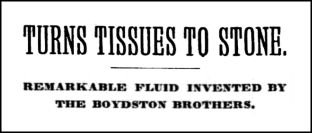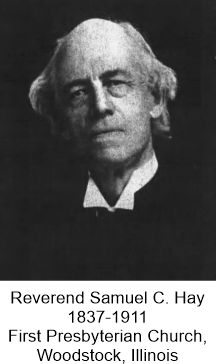|
Thirty-one-year-old machinist, Albert Alfson (b.1872)
brought his eighteen-year-old girlfriend to spend part
of the 1903 holiday with his parents and siblings in
Chicago. He and Margaret / Marguerite Love (b.1885) lived in McHenry County,
Woodstock, IL, about fifty miles northwest of Chicago,
where Albert worked at the Oliver Typewriter factory*
and Margaret as a clerk at a clothing and dry goods store. Albert
and Margaret were planning to marry but had shared
their secret with only a few friends.
The Love family
Nineteen-year-old Margaret May Love (spelled
Marguerite in some reports), nicknamed Maggie,
worked as a clerk for Jurene M. Thomas in Woodstock. She was the
daughter of Scottish immigrant Watson D. Craighead / Greighead Ronning Love (1853–1930) and Watson's
second husband, Irish immigrant William A. Love
(1832–1892), a veteran of the American Civil War.
Maggie was nine years old when her father died,
making her eligible to receive his veteran's
pension.
Watson married William B. Henrie, a fresco painter, and the couple
lived in Delavan, Wisconsin, later returning to Woodstock, IL.
Maggie lived with them in Delavan at least three years before
her death. Through her mother's three marriages Maggie had five
half brothers and sisters.
The Alfson family
Albert was one of eight children born to carpenter
Alexander (1836–1909) and Fredericka Caroline
Johnson Alfson (1840–1927), natives of Norway and
Sweden, of which seven survived prior to Albert's
death at the Iroquois. Albert's living siblings in
1903 were:
| Clara Alfson Hammersmark (John) |
Ida Marie Alfson Phipps (Frank S.) |
| Ella L. Alfson Foster (Charles) |
Hannah Alfson (d.1953) |
| Agnes Alfson Bingham (Theodore) |
John Alfson (d. 1927) |
In 1896-7, before moving to Woodstock, Albert manufactured bicycles and was a
member of a cycling club. By 1898 he described
himself in the city directory as a machinist.
In the accompanying photo from 1901, a group of cyclists
gathered for a race. Albert was most
probably not at this race because he had already
moved to Woodstock by 1901. It is interesting that cycling clubs
were hot at the dawn of the automobile in the same way
that cassette boom boxes were hot at the dawn of the
internet.
Probably standing at the back of the third-floor balcony
A story about the couple in
the Woodstock newspaper was lengthy: one-third of
the front page and another fourteen column
inches on page four. According to the story, the couple
purchased tickets in the front row but their floor was
not reported and Albert's family knew nothing of
what happened to the couple inside the theater.
I conjecture that if Albert had purchased tickets before
December 30, he would have known the floor and
mentioned it to his parents when he told them of his
front-row seats, that had his parents known the floor they
would have shared the information with the newspaper
reporter and, given the length of the story,
if the floor had been known, the information would
have been included in the newspaper story. If
Albert waited to purchase tickets
immediately before the opening curtain, as I
suspect, he may have spoken of his plan to purchase
front-row seats to one of the dozen Woodstock
citizens at the matinee (see list in panel below),
as they entered the theater or while
standing
in the foyer at the theater waiting to
purchase tickets. When he got to the
ticket counter, however, he may have learned, as did
other Iroquois attendees who lived to tell of their
experience, that front row seats were
sold out. For Albert and Margaret, returning on
another day was not a good option. The theater
was closed over the holiday, Albert's devotion to
his Methodist faith would have made attending the
theater on Sunday verboten and they had to be back to work in Woodstock
by Monday. If my many speculations are
correct, the reason other
Woodstock residents did not see Albert and Margaret inside the auditorium
is because they were only able to get standing-room
tickets at the back, and probably in the third-floor
balcony.
The marked difference in the
condition of Albert's and Margaret's bodies
indicates they became separated, with Margaret escaping from the auditorium and Albert
trapped inside and killed by the fireball.
Margaret may have been one of around twenty-five
people, including the
Strong family,
who ran toward the utility stairwell. Once the
wood door there (door
#40) was broken open with fireman Roche's ax, two or three in that
group were found to be alive, if barely. They
were first carried from the stairwell into the
manager's office at the front of the structure
(through door #34). To reach Dyche's
Drugstore, Margaret's bearers would have carried her
past Thompson's diner, which would become the
busiest triage center.
Families search for bodies
First responders took Albert's badly burned body to Rolston's mortuary.
After a two-day search his father, Alexander Alfson,
matched the fabric of a vest to other clothing on
his son's body.
|

|
Margaret's body, though free
of burns or evidence of trampling, was more
difficult to locate. Three from Woodstock took
on the gruesome task: her half-brother, Charles
Arthur Ronning (1879–1917),† Arthur Erickson
(1884–1957), a co-worker of Albert's at Oliver Typewriter, and Jurene
M. Thomas, Margaret's employer. For a short while
the group thought a badly burned body at Rolston's was
Margaret but decided not. Erickson kept searching
and found her unmarked and unburned body at Boydston
Bros. Funeral Home, over five miles south of the
Iroquois Theater at
4227 Cottage Grove Ave. Sounds to me
like funeral business was being spread far and wide.
Reportedly, Margaret was one
of several Iroquois Theater victims carried to a
drugstore where four physicians struggled for two
hours to save her life. The largest number of
victims were triaged through Thompson's diner with a
smaller number taken to Dyche's Drugstore at Randolph
and State.§
I was at first skeptical that
the drugstore scene was connected to Margaret and
the story shared with her family. Upon further reflection,
however, I think it could have happened as described. A triage site
less busy than Thompson's would
have allowed physicians more time to spend trying to
resuscitate the girl and to communicate their
frustration to the wagon driver who carried Margaret's
body to the Boydston's
Funeral home. There too, fewer bodies and a
less frenzied pace would have facilitated more
communication. Unlike Rolston's, Jordan's
and Sheldon's funeral homes, which took in 187, 135 and 47
Iroquois victim bodies, distant Boydston's took in only five.
The mortician and his workers probably knew more
about each of their five victims than was the case
at busier morgues. Boydston was not
alone in receiving only a token bit of the Iroquois
fire business. Furth Undertaking at 192 W.
35th, also five miles away, and Postlewaite
Undertaking at 322 Ogden (today's 1867 Ogden), three
miles away, each received fewer than six.
Boydston may have had particular reason to take note
of the unblemished condition of Margaret's body -
see below.
~~~~~~~~~~~~~~
Just when I start thinking 1903 wasn't much
different than our times, something like this comes
along to remind me that it was over a century ago.
Check out this
newspaper story about 1896 experiments
to invent an embalming fluid that would preserve
corpses by turning them to stone.

~~~~~~~~~~~~~~
Funerals
Albert's funeral was held
Sunday, Jan 3, 1904, at 1 pm in Chicago, conducted
by Rev. Newton A. Sunderlin
(1849-1935) of the
First
United Methodist Church in Woodstock. Two
other pastors participated. reverends Loomis
and Hanson were from the family's church in Chicago,
the Second Swedish Methodist Episcopal Church. Two hundred guests attended,
over half of them from Woodstock, IL,
including his
 Sunday School class. Albert was
described as religiously devout and newspaper
references to his activities seem to bear that out.
He was buried at Mount Olive Cemetery in Chicago.
Sunday School class. Albert was
described as religiously devout and newspaper
references to his activities seem to bear that out.
He was buried at Mount Olive Cemetery in Chicago.
Margaret's funeral service was conducted by Rev. Samuel C.
Hay| at the First Presbyterian Church in Woodstock. The church
choir sang "Saved by Grace," said to be a favorite
that Margaret and Albert liked to sing as a duet.
In the years after the fire
In January 1909 Albert's
family received a $750 (inflation-adjusted to
$21,000) settlement from Fuller
Construction, one of only thirty-five awarded.
Margaret's family did not receive a settlement,
perhaps because her mother did not pursue it.
Watson and William Henrie remained in Woodstock,
possibly making it difficult to oversee a lawsuit in
Chicago. Albert's father, Alexander, passed
away in November that same year. Margaret's
employer, Jurene M. Thomas, closed her store in
Woodstock, relocated and remarried. Arthur
Erickson, who had persisted in the search for
Margaret's body, married Mary Pierson in 1907.
They had one child and settled in Belvidere, IL.
Margaret's half brother, Charles Ronning, remained
in McHenry County and raised four children.
|
